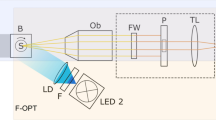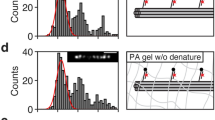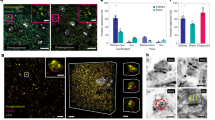Abstract
Hydrogels are extensively used as tunable, biomimetic three-dimensional cell culture matrices, but optically deep, high-resolution images are often difficult to obtain, limiting nanoscale quantification of cell–matrix interactions and outside-in signalling. Here we present photopolymerized hydrogels for expansion microscopy that enable optical clearance and tunable ×4.6–6.7 homogeneous expansion of not only monolayer cell cultures and tissue sections, but cells embedded within hydrogels. The photopolymerized hydrogels for expansion microscopy formulation relies on a rapid photoinitiated thiol/acrylate mixed-mode polymerization that is not inhibited by oxygen and decouples monomer diffusion from polymerization, which is particularly beneficial when expanding cells embedded within hydrogels. Using this technology, we visualize human mesenchymal stem cells and their interactions with nascently deposited proteins at <120 nm resolution when cultured in proteolytically degradable synthetic polyethylene glycol hydrogels. Results support the notion that focal adhesion maturation requires cellular fibronectin deposition; nuclear deformation precedes cellular spreading; and human mesenchymal stem cells display cell-surface metalloproteinases for matrix remodelling.
This is a preview of subscription content, access via your institution
Access options
Access Nature and 54 other Nature Portfolio journals
Get Nature+, our best-value online-access subscription
$29.99 / 30 days
cancel any time
Subscribe to this journal
Receive 12 print issues and online access
$259.00 per year
only $21.58 per issue
Buy this article
- Purchase on Springer Link
- Instant access to full article PDF
Prices may be subject to local taxes which are calculated during checkout




Similar content being viewed by others
Data availability
The data used to prepare the figures, all displayed microscopy images and the raw images used to prepare these images are available at https://doi.org/10.25810/2eb5-8x48.
References
Chen, F., Tillberg, P. W. & Boyden, E. S. Expansion microscopy. Science 347, 543–548 (2015).
Chozinski, T. J. et al. Expansion microscopy with conventional antibodies and fluorescent proteins. Nat. Methods 13, 485–488 (2016).
Tillberg, P. W. et al. Protein-retention expansion microscopy of cells and tissues labeled using standard fluorescent proteins and antibodies. Nat. Biotechnol. 34, 987–992 (2016).
Truckenbrodt, S. et al. X10 expansion microscopy enables 25-nm resolution on conventional microscopes. EMBO Rep. 19, e45836 (2018).
Zhao, Y. et al. Nanoscale imaging of clinical specimens using pathology-optimized expansion microscopy. Nat. Biotechnol. 35, 757–764 (2017).
Alon, S. et al. Expansion sequencing: spatially precise in situ transcriptomics in intact biological systems. Science 371, aax2656 (2021).
Chen, F. et al. Nanoscale imaging of RNA with expansion microscopy. Nat. Methods 13, 679–684 (2016).
Asano, S. M. et al. Expansion microscopy: protocols for imaging proteins and RNA in cells and tissues. Curr. Protoc. Cell Biol. 80, e56 (2018).
Gao, R. et al. A highly homogeneous polymer composed of tetrahedron-like monomers for high-isotropy expansion microscopy. Nat. Nanotechnol. 16, 698–707 (2021).
Tibbitt, M. W., Kloxin, A. M., Sawicki, L. A. & Anseth, K. S. Mechanical properties and degradation of chain and step-polymerized photodegradable hydrogels. Macromolecules 46, 2785–2792 (2013).
Cramer, N. B. & Bowman, C. N. Kinetics of thiol–ene and thiol–acrylate photopolymerizations with real-time Fourier transform infrared. J. Polym. Sci. A Polym. Chem. 39, 3311–3319 (2001).
O’Brien, A. K., Cramer, N. B. & Bowman, C. N. Oxygen inhibition in thiol–acrylate photopolymerizations. J. Polym. Sci. A Polym. Chem. 44, 2007–2014 (2006).
Hoffman, A. S. Hydrogels for biomedical applications. Adv. Drug Deliv. Rev. 64, 18–23 (2012).
Caliari, S. R. & Burdick, J. A. A practical guide to hydrogels for cell culture. Nat. Methods 13, 405–414 (2016).
Rosales, A. M. & Anseth, K. S. The design of reversible hydrogels to capture extracellular matrix dynamics. Nat. Rev. Mater. 1, 15012 (2016).
Rydholm, A. E., Bowman, C. N. & Anseth, K. S. Degradable thiol-acrylate photopolymers: polymerization and degradation behavior of an in situ forming biomaterial. Biomaterials 26, 4495–4506 (2005).
Ye, S., Cramer, N. B. & Bowman, C. N. Relationship between glass transition temperature and polymerization temperature for cross-linked photopolymers. Macromolecules 44, 490–494 (2011).
Jones, B. et al. Curing behavior, chain dynamics, and microstructure of high Tg thiol-acrylate networks with systematically varied network heterogeneity. Polymer 205, 122783 (2020).
Lee, H. et al. Tetra-gel enables superior accuracy in combined super-resolution imaging and expansion microscopy. Sci. Rep. 1, 16944 (2021).
Flory, P. J. Molecular size distribution in three dimensional polymers. I. Gelation. J. Am. Chem. Soc. 63, 3083–3090 (1941).
Fairbanks, B. D., Schwartz, M. P., Bowman, C. N. & Anseth, K. S. Photoinitiated polymerization of PEG-diacrylate with lithium phenyl-2,4,6-trimethylbenzoylphosphinate: polymerization rate and cytocompatibility. Biomaterials 30, 6702–6707 (2009).
Hell, S. W. Far-field optical nanoscopy. Science 316, 1153–1158 (2007).
Goulding, D., Bullard, B. & Gautel, M. A survey of in situ sarcomere extension in mouse skeletal muscle. J. Muscle Res. Cell Motil. 18, 465–472 (1997).
Mauro, A. Satellite cell of skeletal muscle fibers. J. Biophys. Biochem. Cytol. 9, 493–495 (1961).
Blatchley, M. R. et al. In situ super‐resolution imaging of organoids and extracellular matrix interactions via photo‐transfer by allyl sulfide exchange-expansion microscopy (PhASE‐ExM). Adv. Mat. 18, 2109252 (2022).
Loebel, C., Mauck, R. L. & Burdick, J. A. Local nascent protein deposition and remodelling guide mesenchymal stromal cell mechanosensing and fate in three-dimensional hydrogels. Nat. Mater. 18, 883–891 (2019).
Ferreira, S. A. et al. Bi-directional cell-pericellular matrix interactions direct stem cell fate. Nat. Commun. 9, 4049 (2018).
Brown, T. E. et al. Secondary photocrosslinking of click hydrogels to probe myoblast mechanotransduction in three dimensions. J. Am. Chem. Soc. 140, 11585–11588 (2018).
Cukierman, E., Pankov, R., Stevens, D. R. & Yamada, K. M. Taking cell-matrix adhesions to the third dimension. Science 294, 1708–1712 (2001).
Li, C. W., Lau, Y. T., Lam, K. L. & Chan, B. P. Mechanically induced formation and maturation of 3D-matrix adhesions (3DMAs) in human mesenchymal stem cells. Biomaterials 258, 120292 (2020).
Yamada, K. M. & Sixt, M. Mechanisms of 3D cell migration. Nat. Rev. Mol. Cell Biol. 20, 738–752 (2019).
Friedl, P., Wolf, K. & Lammerding, J. Nuclear mechanics during cell migration. Curr. Opin. Cell Biol. 23, 55–64 (2011).
Cramer, L. P. Forming the cell rear first: breaking cell symmetry to trigger directed cell migration. Nat. Cell Biol. 12, 628–632 (2010).
Wolf, K. et al. Collagen-based cell migration models in vitro and in vivo. Semin. Cell Dev. Biol. 20, 931–941 (2009).
Wolf, K. et al. Physical limits of cell migration: control by ECM space and nuclear deformation and tuning by proteolysis and traction force. J. Cell Biol. 201, 1069–1084 (2013).
Rehmann, M. S. et al. Tuning and predicting mesh size and protein release from step growth hydrogels. Biomacromolecules 18, 3131–3142 (2017).
Wolf, K. et al. Multi-step pericellular proteolysis controls the transition from individual to collective cancer cell invasion. Nat. Cell Biol. 9, 893–904 (2007).
Woskowicz, A. M., Weaver, S. A., Shitomi, Y., Ito, N. & Itoh, Y. MT-LOOP-dependent localization of membrane type I matrix metalloproteinase (MT1-MMP) to the cell adhesion complexes promotes cancer cell invasion. J. Biol. Chem. 288, 35126–35137 (2013).
Shofuda, T. et al. Cleavage of focal adhesion kinase in vascular smooth muscle cells overexpressing membrane-type matrix metalloproteinases. Arterioscler. Thromb. Vasc. Biol. 24, 839–844 (2004).
Paul, N. R. et al. α5β1 integrin recycling promotes Arp2/3-independent cancer cell invasion via the formin FHOD3. J. Cell Biol. 210, 1013–1031 (2015).
Petrie, R. J. & Yamada, K. M. Multiple mechanisms of 3D migration: the origins of plasticity. Curr. Opin. Cell Biol. 42, 7–12 (2016).
Xiao, P. et al. Visible light sensitive photoinitiating systems: recent progress in cationic and radical photopolymerization reactions under soft conditions. Prog. Polym. Sci. 41, 32–66 (2015).
Hautanen, A., Gailit, J., Mann, D. M. & Ruoslahti, E. Effects of modifications of the RGD sequence and its context on recognition by the fibronectin receptor. J. Biol. Chem. 264, 1437–1442 (1989).
Benoit, D. S. W. et al. Integrin-linked kinase production prevents anoikis in human mesenchymal stem cells. J. Biomed. Mater. Res. A 81, 259–268 (2007).
Hennessy, K. M. et al. The effect of RGD peptides on osseointegration of hydroxyapatite biomaterials. Biomaterials 29, 3075–3083 (2008).
Azagarsamy, M. A. & Anseth, K. S. Wavelength-controlled photocleavage for the orthogonal and sequential release of multiple proteins. Angew. Chem. Int. Ed. 52, 13803–13807 (2013).
Grim, J. C. et al. A reversible and repeatable thiol–ene bioconjugation for dynamic patterning of signaling proteins in hydrogels. ACS Cent. Sci. 4, 909–916 (2018).
Alisafaei, F., Jokhun, D. S., Shivashankar, G. V. & Shenoy, V. B. Regulation of nuclear architecture, mechanics, and nucleocytoplasmic shuttling of epigenetic factors by cell geometric constraints. Proc. Natl Acad. Sci. USA 116, 13200–13209 (2019).
Walker, C. J. et al. Nuclear mechanosensing drives chromatin remodelling in persistently activated fibroblasts. Nat. Biomed. Eng. 5, 1485–1499 (2021).
Cosgrove, B. D. et al. Nuclear envelope wrinkling predicts mesenchymal progenitor cell mechano-response in 2D and 3D microenvironments. Biomaterials 270, 120662 (2021).
Thevenaz, P., Ruttimann, U. E. & Unser, M. A pyramid approach to subpixel registration based on intensity. IEEE Trans. Image Process. 7, 27–41 (1998).
Koon, D.-J. B-spline grid, image and point based registration v.1.33.0.0 (MathWorks, 2011).
Vogler, T. O., Gadek, K. E., Cadwallader, A. B., Elston, T. L. & Olwin, B. B. Isolation, culture, functional assays, and immunofluorescence of myofiber-associated satellite cells. Methods Mol. Biol. 1460, 141–162 (2016).
Yang, C., Tibbitt, M. W., Basta, L. & Anseth, K. S. Mechanical memory and dosing influence stem cell fate. Nat. Mater. 13, 645–652 (2014).
Rao, V. V., Vu, M. K., Ma, H., Killaars, A. R. & Anseth, K. S. Rescuing mesenchymal stem cell regenerative properties on hydrogel substrates post serial expansion. Bioeng. Transl. Med. 4, 51–60 (2019).
Dong, X., Al-Jumaily, A. & Escobar, I. C. Investigation of the use of a bio-derived solvent for non-solvent-induced phase separation (NIPS) fabrication of polysulfone membranes. Membranes 8, 23 (2018).
Sim, S.-L. et al. Branched polyethylene glycol for protein precipitation. Biotechnol. Bioeng. 109, 736–746 (2012).
Lu, S. & Anseth, K. S. Release behavior of high molecular weight solutes from poly(ethylene glycol)-based degradable networks. Macromolecules 33, 2509–2515 (2000).
Cruise, G. M., Scharp, D. S. & Hubbell, J. A. Characterization of permeability and network structure of interfacially photopolymerized poly(ethylene glycol) diacrylate hydrogels. Biomaterials 19, 1287–1294 (1998).
Merrill, E. W., Dennison, K. A. & Sung, C. Partitioning and diffusion of solutes in hydrogels of poly(ethylene oxide). Biomaterials 14, 1117–1126 (1993).
Lustig, S. R. & Peppas, N. A. Solute diffusion in swollen membranes. IX. Scaling laws for solute diffusion in gels. J. Appl. Polym. Sci. 36, 735–747 (1988).
Acknowledgements
This work was supported by grants from the National Institutes of Health (DE016523 and DK120921 to K.S.A. and AR049446 to B.B.O.). We thank J. Dragavon and the BioFrontiers Institute Advanced Light Microscopy Core (RRID, SCR 018302) for the discussions and support with confocal microscopes used in this study: a Nikon A1R confocal microscope via a National Institute of Standards and Technology University of Colorado (CU) cooperative grant (70NANB15H226) and an Imaris Workstation funded by a National Institutes of Health grant (1S10RR026680-01A1).
Author information
Authors and Affiliations
Contributions
K.A.G., B.B.O., E.S.B. and K.S.A. designed the experiments. K.A.G., T.-L.C., N.P.S. and V.V.R. carried out GtG experiments. K.A.G., L.J.M., N.P.S. and T.E.B. designed and prepared the PhotoExM formulations. T.-L.C., A.A.C. and J.S.S. carried out the expansion of muscle tissue sections and myofibres. K.A.G., N.P.S., C.Z. and C.-C.Y. carried out the non-rigid registration experiments. N.P.S. carried out the fluorophore photobleaching experiments. K.A.G. and K.S.A. wrote the paper. All authors contributed to the discussion of the data.
Corresponding author
Ethics declarations
Competing interests
E.S.B. discloses cofounding a company that pursues commercial applications of expansion microscopy. B.B.O. discloses a potential conflict of interest as a Scientific Advisory Board Member for Satellos Biosciences. The other authors declare no competing interests.
Peer review
Peer review information
Nature Materials thanks Kwanghun Chung and the other, anonymous, reviewer(s) for their contribution to the peer review of this work.
Additional information
Publisher’s note Springer Nature remains neutral with regard to jurisdictional claims in published maps and institutional affiliations.
Supplementary information
Supplementary Information
Supplementary Figs. 1–8, Tables 1 and 2 and References.
Rights and permissions
Springer Nature or its licensor (e.g. a society or other partner) holds exclusive rights to this article under a publishing agreement with the author(s) or other rightsholder(s); author self-archiving of the accepted manuscript version of this article is solely governed by the terms of such publishing agreement and applicable law.
About this article
Cite this article
Günay, K.A., Chang, TL., Skillin, N.P. et al. Photo-expansion microscopy enables super-resolution imaging of cells embedded in 3D hydrogels. Nat. Mater. 22, 777–785 (2023). https://doi.org/10.1038/s41563-023-01558-5
Received:
Accepted:
Published:
Issue Date:
DOI: https://doi.org/10.1038/s41563-023-01558-5
This article is cited by
-
SpiDe-Sr: blind super-resolution network for precise cell segmentation and clustering in spatial proteomics imaging
Nature Communications (2024)



